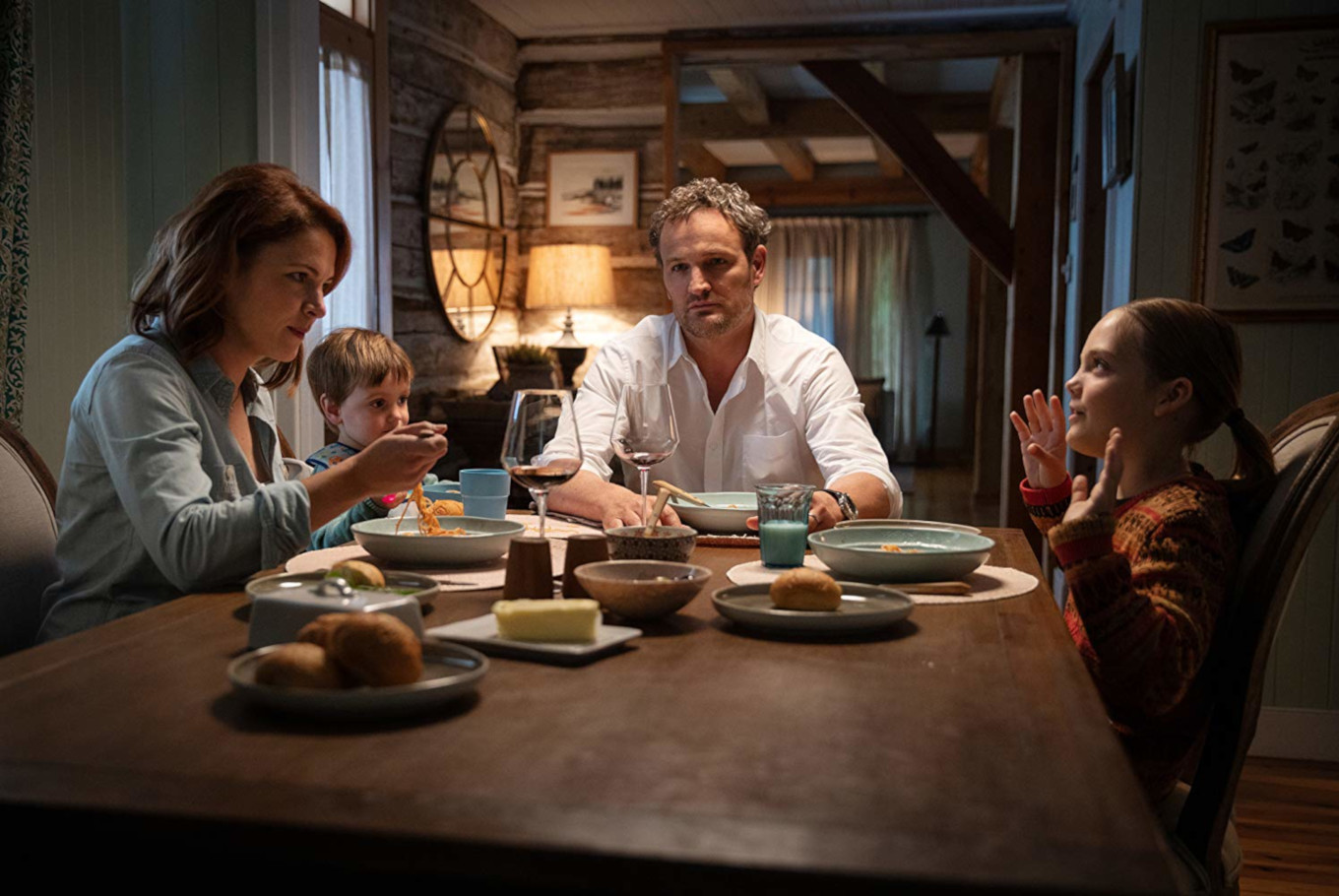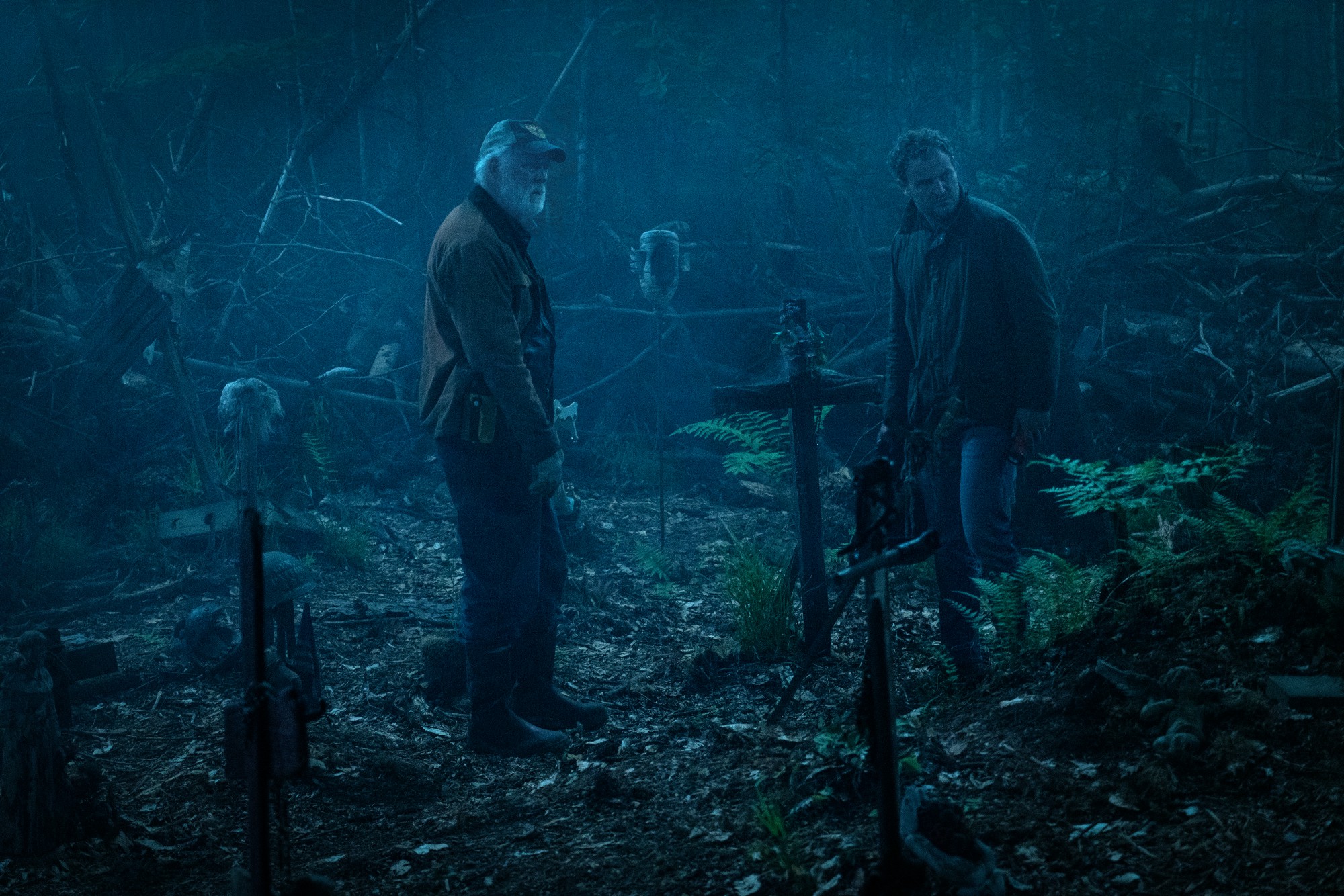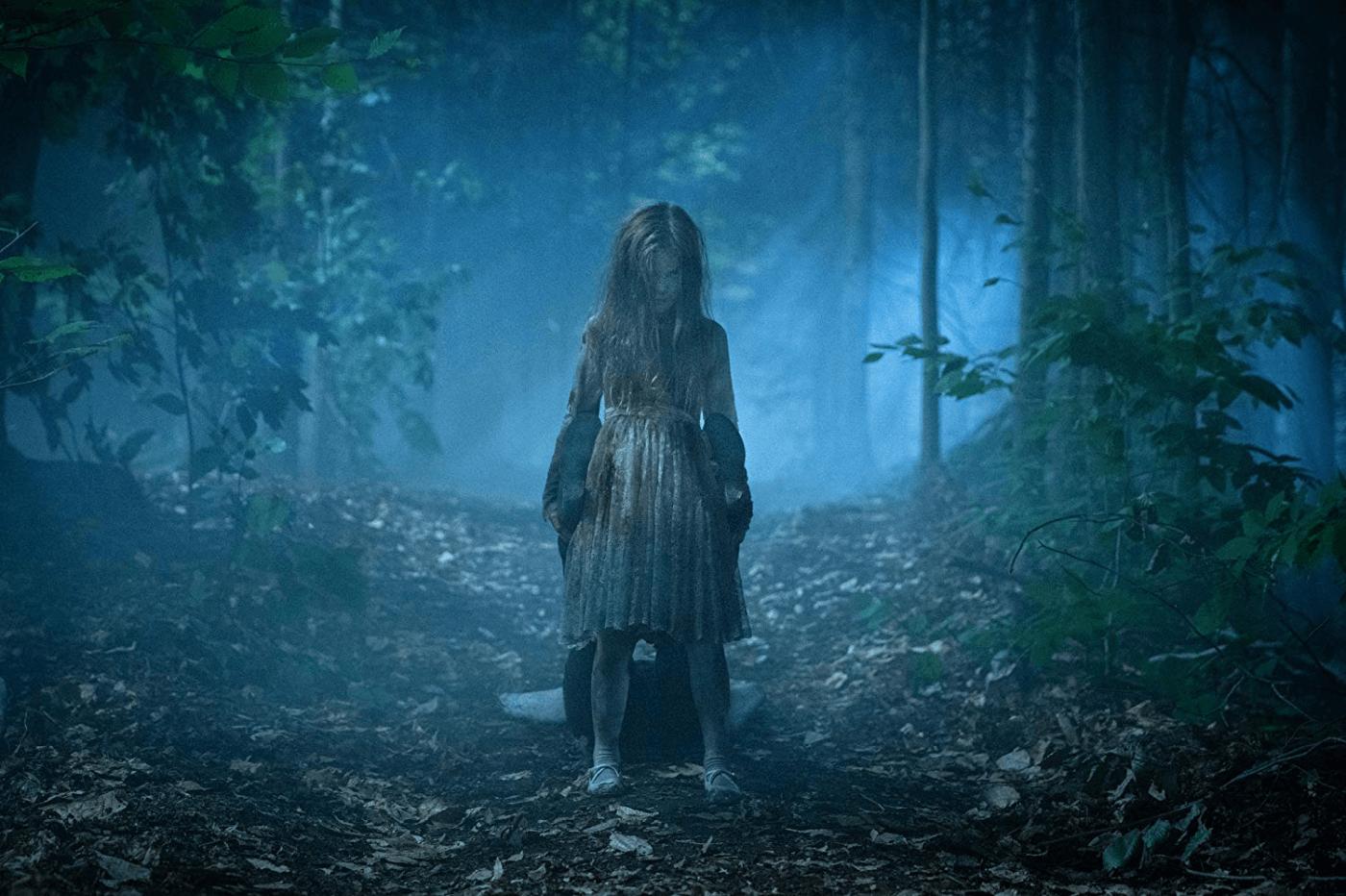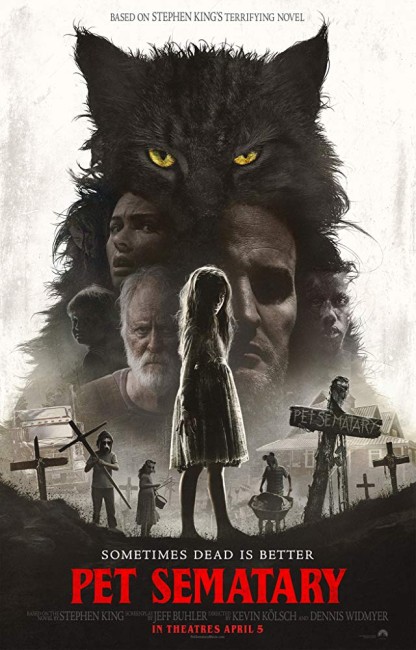USA. 2019.
Crew
Directors – Kevin Kölsch & Dennis Widmyer, Screenplay – Jeff Buhler, Story – Matt Greenberg, Based on the Novel by Stephen King, Producers – Lorenzo di Bonaventura, Steven Schneider & Mark Vahradian, Photography – Laurie Rose, Music – Christopher Young, Visual Effects – Mr. X (Supervisor – Damien Hurgon), Special Effects Supervisor – Louis Craig, Makeup Effects – Morot FX Studio (Designer – Adrien Morot), Production Design – Todd Cherniawsky. Production Company – di Bonaventura Pictures/Room 101, Inc..
Cast
Jason Clarke (Louis Creed), Amy Seimetz (Rachel Creed), John Lithgow (Jud Crandall), Jeté Laurence (Ellie Creed), Hugo Lavoie & Lucas Lavoie (Gage Creed), Obssa Ahmed (Victor Pascow), Alyssa Levine (Zelda), Sonia Maria Chirilla (Young Rachel)
Plot
Louis Creed, his wife Rachel, their eight year-old daughter Ellie and three year-old son Gage move to Ludlow, Maine so that Louis can take a job as a doctor at the local university hospital. The house they are provided with is on a road that has a number of trucks passing by. They befriend neighbour Jud Crandall. Jud then shows Louis that the family cat Church, beloved by Ellie, has been hit by a truck. That night, Jud takes Louis to the Pet Sematary behind the house and through the woods up into an old Indian burial ground and gets him to bury Church there. In the morning, Louis is startled to find Church alive again. However, he soon begins to find that Church has returned not the same and is more vicious in nature. Next, while holding a birthday party, Ellie runs out onto the road and is hit by the unhooked tanker of a skidding truck. In the aftermath of his grief, Louis begins to think about taking Ellie’s body out to the Indian burial ground beyond the Pet Sematary.
Pet Sematary (1983) was Stephen King’s tenth published novel. In 1979, King was a writer-in-residence at the University of Maine and had been provided with a live-in house to go with the position. The house was near a highway where a number of trucks passed by and his daughter’s cat was killed by one of these. King and his wife had had at least three of their children by then so it is not hard to imagine that the story was fuelled by King’s own real-life fears about one of the children running out onto the road. Being King, this was then fed through his horror imaginings to ask what would happen if cat and child were brought back to life. Pet Sematary has become regarded as one of King’s most frightening works, its reputation boosted in no small part by the oft-repeated quote from King that it is the only one of his books that scared him.
The book was adapted into a film with Pet Sematary (1989) by director Mary Lambert from a script from King himself with Dale Midkiff as Louis, Denise Crosby as Rachel and Fred Gwynne perfectly cast as Jud. This was okay translation of the book if never a standout classic in the same way that people regard the book as the scariest of King’s works. Mary Lambert went on to direct a sequel with Pet Sematary II (1992) with teenager Edward Furlong bringing his late mother back.
2017 brought a huge renaissance of Stephen King adaptations, boosted by the massive box-office success of the remake of It (2017). This seemed to precipitate a spate of other adaptations that has so far included films like The Dark Tower (2017), 1922 (2017), Gerald’s Game (2017), the Shining sequel Doctor Sleep (2019), Firestarter (2022), Mr Harrigan’s Phone (2022), The Boogeyman (2023), The Life of Chuck (2024), Salem’s Lot (2024), The Long Walk (2025), The Monkey (2025) and The Running Man (2025), and tv series such as The Mist (2017), Mr. Mercedes (2017-9), Castle Rock (tv series, 2018-9), Creepshow (2019- ), The Stand (tv mini-series, 2020-1), Chapelwaite (tv series, 2021) and Lisey’s Story (tv mini-series, 2021). That’s aside from the long list of King adapted works we have had over the preceding five decades – see bottom of the page.

Pet Sematary comes from the directing duo of Kevin Kölsch and Dennis Widmeyer. The two had previously collaborated on Postcards from the Future: The Chuck Palahniuk Documentary (2003) and the thriller Absence (2009) and then had a reasonable word of mouth success with the very strange Hollywood horror Starry Eyes (2014). They also directed the Valentine’s Day episode of the horror anthology Holidays (2016). The remake is produced by Lorenzo di Bonaventura, the big name Hollywood producer mostly known for the Transformers films. The screenplay comes from Jeff Buhler who also wrote the Clive Barker adaptation The Midnight Meat Train (2008), the remake of Jacob’s Ladder (2019), The Prodigy (2019), The Grudge (2020) and Studio 666 (2022), as well as created/produced the George R.R. Martin adapted tv series Nightflyers (2018) and directed the horror film Insanitarium (2008).
Pet Sematary did not get a very good reception when it came out. A good deal of this is to do with audience’s reaction to one principal change to the story, which I will discuss in depth below. The surprise about the new version in watching it is that, bar this one change, it is otherwise extremely faithful to the Stephen King source novel. There are times you feel like the writers have just cut-and-pasted whole sections from the book – Jud saving Ellie from the bee sting; her fears about death; Victor Pascow’s entrance and warnings of “don’t cross the barrier”; Pascow’s reappearances to Louis in a dream and Louis waking to find he has muddy feet; the backstory of the Pet Sematary with Jud describing how he resurrected his dog Sniffer and Louis looking online and finding the story of Timothy Bateman, the history of the unclaimed Indian lands and talk of the wendigo; mention made of how the burial ground twists things to make it desirable to go out there; Louis drugging Jud.
Even the description of the Pet Sematary with its graves in whorl patterns, the barrier made up of fallen branches, the journey through the woods with Louis stepping in something watery, hearing things in woods and the ascent up the stairs to the burial ground has been taken directly from the way King describes it in the book. What is noticeable about this is that none of this is present in the 1989 film, which actually had a script by King himself.

We then come to the film’s one big change, namely that it is Ellie (the eight year-old daughter) rather than Gage (who is three years-old) who gets killed. I am not sure of the reasons for this. I suspect that it may have something to do with the increasing calls for diversity in Hollywood in recent years, which have unimaginatively come down to rehashing familiar properties but with the genders swapped – see Ghostbusters (2016), Oceans 8 (2018), Doctor Who (2005- ), What Men Want (2019). (Although if that is the case, why didn’t we simply end up with a three year-old Ellie and Gage recast as the older kid?) Or it might simply be a desire to shake up audience’s familiarity with the story and do something different.
Knowing the twist the show was pulling in advance (it is hard not to – the film even advertises on the poster and in the trailer), I decided to go with it. Certainly, the film has one good scene where Jeté Laurence asks Jason Clarke to lie down beside her on the bed where you see that the idea of the resurrected child who parrots the familiar things they have always said back at the parent has something potentially far spookier to it than just a resurrected barely speaking child.
On the other hand, the remake does nothing with this idea. For all that it matters to the film, bar the abovementioned scene, you could have substituted a resurrected Gage for a resurrected Ellie and it would have made no difference. My feeling is that if you are going to place as big a spin as that on the original, it better have some purpose other than being “I wonder what would happen if we swapped around which kid gets killed.” For all the faithfulness to King’s text in the earlier sections, there is also the absurdity of the ending where the film freely rewrites King’s dark ending for something altogether different. It is this that finally puts the nail in the film’s coffin, departing from King’s realistically grounded horrors into the merely silly.

Jason Clarke has a body of work that shows he is a much better actor than Dale Midkiff who played Louis in the 1989 film, but he is given surprisingly little to do. We get one or two shots of him staring shattered at the graveside but the film does almost nothing to take us inside his interior spaces and the step over to the dark side that he makes to resurrect Ellie. Even what should have been the emotionally shattering death of Ellie is killed by the absurdity of having to blow the sequence up into something big and have her not merely being killed by a truck but an unhooked tanker skidding along the road. The absurdity of the sequence is that normally a tanker weighs around six tons (more depending on what it is carrying) meaning that the impact would reduce anyone hit by it to a smear on the road whereas what we we see is a body with not even a drop of blood near it.
The main problem with Pet Sematary is that for a novel that is often regarded as Stephen King’s scariest, the film offers nothing that is scary. The worst part of the film is the use of Zelda, Rachel’s sister who suffered from spinal meningitis. Zelda is there in the novel and the remake does a fairly accurate replication of the scene from the book where young Rachel is left home alone and sent in to feed her and of Zelda’s death down the dumb waiter. Zelda makes a brief appearance in the 1989 film (the remake seems to have borrowed the look and makeup design).
Here Zelda gains more of a prominence than she does in either the book and 1989 film combined and becomes like a pop-up boogey person who is constantly turning up in Rachel’s imagination. We don’t even get a speaking appearance from Rachel’s parents (who have a more prominent role in the book) but Rachel’s return home is dominated by her imagining hearing Zelda whispering and rattling inside the walls. My feeling is that when you are remaking a horror classic that concerns both a resurrected cat and resurrected child and that in itself is not providing enough scares such that you have to keep piling on jumps from a sister suffering from a disfiguring condition as well, then you are fundamentally going about it in the wrong way.
Pet Sematary: Bloodlines (2023) was a prequel from Jeff Buhler and Lorenzo di Bonaventura, which told of further events during Jud Crandall’s earlier years.
Other Stephen King genre adaptations include:- Carrie (1976), Salem’s Lot (1979), The Shining (1980), Christine (1983), Cujo (1983), The Dead Zone (1983), Children of the Corn (1984), Firestarter (1984), Cat’s Eye (1985), Silver Bullet (1985), The Running Man (1987), Pet Sematary (1989), Graveyard Shift (1990), It (tv mini-series, 1990), Misery (1990), a segment of Tales from the Darkside: The Movie (1990), Sometimes They Come Back (1991), The Lawnmower Man (1992), The Dark Half (1993), Needful Things (1993), The Tommyknockers (tv mini-series, 1993), The Stand (tv mini-series, 1994), The Langoliers (tv mini-series, 1995), The Mangler (1995), Thinner (1996), The Night Flier (1997), Quicksilver Highway (1997), The Shining (tv mini-series, 1997), Trucks (1997), Apt Pupil (1998), The Green Mile (1999), The Dead Zone (tv series, 2001-2), Hearts in Atlantis (2001), Carrie (tv mini-series, 2002), Dreamcatcher (2003), Riding the Bullet (2004), ‘Salem’s Lot (tv mini-series, 2004), Secret Window (2004), Desperation (tv mini-series, 2006), Nightmares & Dreamscapes: From the Stories of Stephen King (tv mini-series, 2006), 1408 (2007), The Mist (2007), Children of the Corn (2009), Everything’s Eventual (2009), the tv series Haven (2010-5), Carrie (2013), Under the Dome (tv series, 2013-5), Big Driver (2014), A Good Marriage (2014), Mercy (2014), Cell (2016), 11.22.63 (tv mini-series, 2016), The Dark Tower (2017), Gerald’s Game (2017), It (2017), The Mist (tv series, 2017), Mr. Mercedes (tv series, 2017-9), 1922 (2017), Castle Rock (tv series, 2018-9), Doctor Sleep (2019), In the Tall Grass (2019), The Outsider (tv series, 2020), The Stand (tv mini-series, 2020-1), Chapelwaite (tv series, 2021), Lisey’s Story (tv mini-series, 2021), Firestarter (2022), Mr Harrigan’s Phone (2022), The Boogeyman (2023), The Life of Chuck (2024), Salem’s Lot (2024), The Long Walk (2025), The Monkey (2025) and The Running Man (2025). Stephen King had also written a number of original screen works with Creepshow (1982), Golden Years (tv mini-series, 1991), Sleepwalkers (1992), Storm of the Century (tv mini-series, 1999), Rose Red (tv mini-series, 2002) and the tv series Kingdom Hospital (2004), as well as adapted his own works with the screenplays for Cat’s Eye, Silver Bullet, Pet Semetary, The Stand, The Shining, Desperation, Children of the Corn 2009, A Good Marriage, Cell and Lisey’s Story. King also directed one film with Maximum Overdrive (1986). Stephen King on Screen (2022) is a documentary about King film adaptations.
Trailer here


